To help celebrate and raise awareness for Endangered Species Day, Digital Dialogs is highlighting a recent dusky seaside sparrow exhibit released by the former FLENH Coordinator, Erin Peel, who also shares some other endangered species resources from within the Florida Environment & Natural History (FLENH) Collection.

In 2006, National Endangered Species Day was established to help educate the public about threatened and endangered species and the Endangered Species Act of 1973 [1]. Today, this law is the primary means for imperiled species to receive rights and potential protection from extinction. The Endangered Species Act rode the coattails of the Endangered Species Preservation Act of 1966 and the Endangered Species Conservation Act of 1969. During this era of conservation reform, several species were actively battling for survival, one of which was the dusky seaside sparrow. Duskies had the honor, and burden, of being named on the very first endangered species list [2]. These sparrows were endemic to the Titusville, Florida, area and one of eight subspecies of seaside sparrows. The featured Storymap, Endling: A Journey to Extinction, details the discovery and downfall of this unpretentious bird. Although once so numerous that they could be easily spotted from the road without ever even leaving the car, a combination of several factors quickly led to the drastic decline and eventual extinction of this bird. The duskies’ primary threats came from the construction of the Cape Canaveral Space Station and everything that accompanied it: mosquito control, development, and highway expansions. Additionally, the duskies suffered blows from natural disasters until only 13 birds remained, forcing emergency action and the development of a breeding program. The program began at Santa Fe Community Teaching Zoo in Gainesville, Florida, eventually migrating to Discovery Island at Walt Disney World in Orlando. Because the only surviving duskies captured from the wild were males, a cross-breeding program with Scott’s seaside sparrows was initiated. The program had mild success, but in 1989, a storm caused damage to their enclosure, leaving all dusky offspring presumed dead.
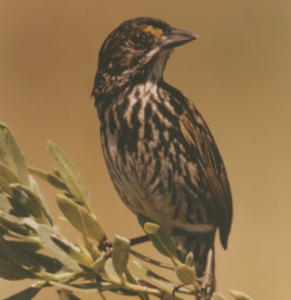
The duskies’ limited distribution and unassuming nature may have contributed to their extinction because they did not elicit mass media attention and public support. The Cape Sable seaside sparrow, who was also on the first endangered species list, still fights for survival. Their demeanor and distribution parallels the duskies as they are restricted to only a small area of the Everglades. Thankfully, large portions of the Everglades are already protected, giving these sparrows a better chance at survival. The harsh lessons learned from the duskies’ demise have helped inform future breeding and survival programs, such as those for another endemic bird, the Florida grasshopper sparrow, whose populations are now slowly recovering. Please read the full Storymap for a more detailed look at the history and struggle of these native Florida sparrows through the lens of materials available at Special Collections. The majority of the resources are from the newly acquired Florida Audubon Society Maitland Records; however, the Florida Ornithological Society Records were also recently updated to include dusky documents and photographs.
Although the Endangered Species Act was too little too late to save the dusky, it has been instrumental in recovering several other species that were also part of the original endangered species list, including whooping cranes, Florida manatees, and American alligators (Yes! Apparently, they were once endangered!) The Florida Environment & Natural History (FLENH) unit within Special Collections functions to collect and curate materials related to Florida’s unique natural history with the hopes of helping preserve the past in order to safeguard Florida’s future. Check out the following digitized FLENH resources to learn about some other endangered or threatened species within Florida:
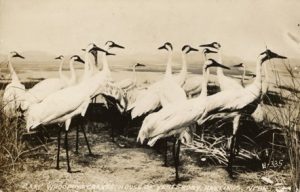
Whooping cranes in a field (https://digitalcommons.usf.edu/rpa_photographs/211/) Whooping cranes & Roseate spoonbills: Special Collections is also home to the National Audubon Society’s Robert Porter Allen Collection. Allen was credited as “the savior of the whooping cranes,” helping discover and protect their breeding grounds to bring the species back from the brink of extinction (~15 individuals) [3]. Allen was also instrumental in the recovery of spoonbills after the populations had been decimated from plume hunting. Research and notes on both species fill the collection held at the Tampa library. Search the whole collection on ArchivesSpace!
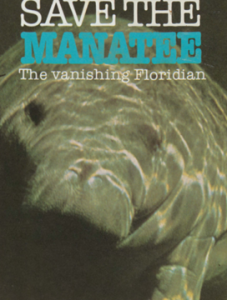 Florida manatees: Because of the success of recovery efforts, the Florida manatee was downlisted from endangered to threatened in 2017. However, due to high mortality rates since 2020, Florida legislators are considering returning manatees to the endangered list [4]. FLENH contains several items related to manatee conservation, such as Save the Manatee: The Vanishing Floridian and Florida’s Manatee: An Educator’s Guide.
Florida manatees: Because of the success of recovery efforts, the Florida manatee was downlisted from endangered to threatened in 2017. However, due to high mortality rates since 2020, Florida legislators are considering returning manatees to the endangered list [4]. FLENH contains several items related to manatee conservation, such as Save the Manatee: The Vanishing Floridian and Florida’s Manatee: An Educator’s Guide.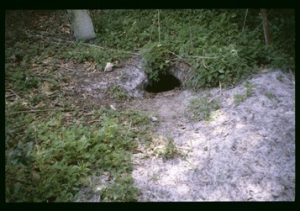
Gopher Tortoise burrow in the Lower Green Swamp Nature Preserve (https://digitalcommons.usf.edu/elapp/140/ ) Gopher tortoises: It wasn’t until 2007 that gopher tortoises were recognized as threatened. Prior to this, developers simply paid to bury gopher tortoises alive that were found on their site [5]. Today, tortoises are required to be relocated, and they are specifically included in inventory checklists, surveys, and analyses when evaluating land status and conservation value. FLENH’s Environmental Lands Acquisition and Protection Program (ELAPP) Collection has photos and survey materials concerning this protected species. For more information on ELAPP try listening to some Oral Histories from key members, including Sally Thompson, who also has an individual collection within FLENH.
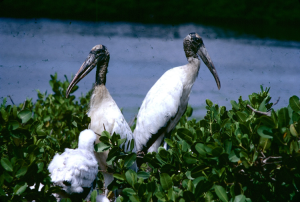
Two adult wood storks on nest with chick (https://digitalcommons.usf.edu/aesc_photographs/788/). Wood storks: Although considered “least concern” globally, these birds are currently categorized as threatened within the US but were listed as endangered from 1984-2014 [6]. One of the largest and most famous wood stork colonies resides in Corkscrew Swamp Sanctuary. FLENH possesses the archival records for Corkscrew, including many documents related to wood stork nesting and foraging patterns. Wood storks also commonly nest in the Everglades. Consequently, they are often noted within FLENH’s Audubon Society Everglades Science Center Records from Tavernier, Florida.
References:
[1] Endangered Species Coalition. (n.d.). Endangered Species Day. https://www.endangered.org/campaigns/endangered-species-day/
[2] U.S. Fish & Wildlife Service. (n.d.). First Species Listed as Endangered. https://www.fws.gov/program/endangered-species/first-endangered-species.html
[3] Endangered Species Coalition. (n.d.). Whooping Crane. https://www.endangered.org/animals/whooping-crane-2/
[4] Harvard Law School (2023, October 11). Manatees Move Toward Restored Endangered Species Safeguards. https://animal.law.harvard.edu/news-article/manatee-protection/
[5] The Gainesville Sun. (2007, June 14). Developers Not Allowed to Bury Gopher Tortoises. https://www.gainesville.com/story/news/2007/06/14/developers-not-allowed-to-bury-gopher-tortoises/31527936007/
[6] Florida Fish & Wildlife Conservation Commission. (n.d.). Wood Stork. https://myfwc.com/wildlifehabitats/profiles/birds/waterbirds/wood-stork/